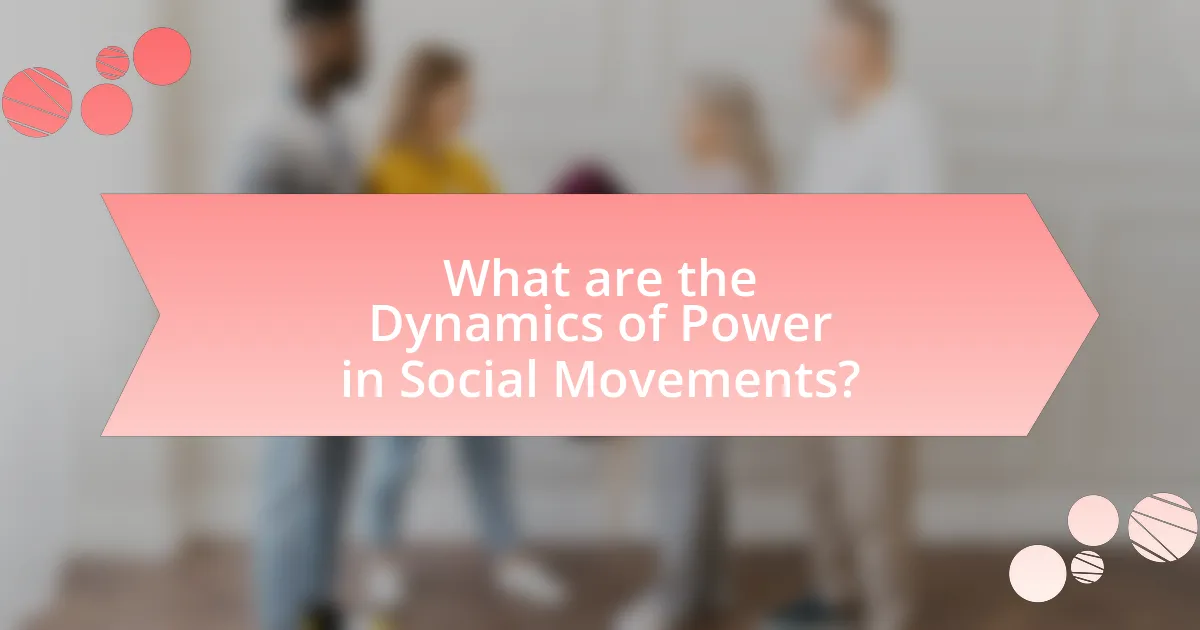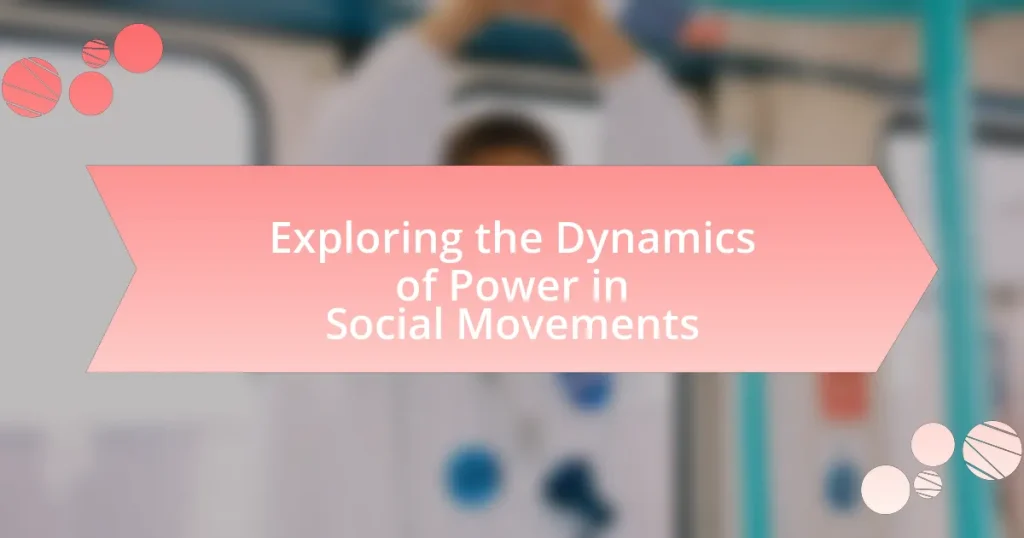The article “Exploring the Dynamics of Power in Social Movements” examines the intricate relationships and interactions among individuals, organizations, and institutions that shape social movements’ goals and outcomes. It highlights the significance of power dynamics in the formation, leadership, and grassroots participation of movements, using historical examples such as the Civil Rights Movement to illustrate how power can be mobilized for social change. Key factors influencing these dynamics include leadership structure, resource mobilization, political opportunities, and collective identity, while external factors like government response and media portrayals also play crucial roles. The article further discusses the implications of hierarchical versus decentralized structures, the importance of coalition-building, and strategies for managing internal conflicts, providing a comprehensive understanding of how power dynamics affect the success or failure of social movements.

What are the Dynamics of Power in Social Movements?
The dynamics of power in social movements involve the relationships and interactions between various actors, including individuals, organizations, and institutions, that influence the movement’s goals and outcomes. Power dynamics manifest through resource mobilization, collective identity formation, and strategic framing, which shape how movements gain support and challenge existing power structures. For instance, the Civil Rights Movement in the United States effectively utilized grassroots organizing and media strategies to amplify their message, demonstrating how power can be harnessed to effect social change. Additionally, research by Charles Tilly highlights that social movements often negotiate power through contentious performances, which can shift public perception and policy.
How do power dynamics influence the formation of social movements?
Power dynamics significantly influence the formation of social movements by determining which groups have the resources, authority, and legitimacy to mobilize support and effect change. For instance, marginalized communities often face systemic barriers that limit their ability to organize, while those in positions of power can leverage their influence to shape narratives and policies. Historical examples, such as the Civil Rights Movement in the United States, illustrate how power imbalances prompted collective action against oppression, as activists sought to challenge the dominant social order and demand equal rights. Additionally, research by Charles Tilly in “Social Movements, 1768-2004” highlights that social movements often arise in response to perceived injustices and the unequal distribution of power, reinforcing the idea that power dynamics are central to understanding the emergence and success of these movements.
What roles do leaders play in shaping power dynamics within movements?
Leaders play a crucial role in shaping power dynamics within movements by influencing direction, mobilizing resources, and establishing legitimacy. They set the agenda and priorities, which can determine the movement’s focus and strategies. For instance, leaders like Martin Luther King Jr. in the Civil Rights Movement effectively articulated goals that resonated with a broad audience, thereby consolidating support and enhancing the movement’s power. Additionally, leaders often serve as the face of the movement, which can attract media attention and public interest, further amplifying their influence. Research indicates that effective leadership can significantly enhance a movement’s ability to achieve its objectives, as seen in studies of social movements that highlight the correlation between strong leadership and successful outcomes.
How does grassroots participation affect power structures in social movements?
Grassroots participation significantly alters power structures in social movements by decentralizing authority and amplifying marginalized voices. This shift occurs as grassroots efforts mobilize individuals at the community level, fostering collective action that challenges established hierarchies. For instance, the Civil Rights Movement in the United States saw grassroots organizations like the Student Nonviolent Coordinating Committee (SNCC) empower local activists, leading to significant policy changes and greater representation in political processes. Such participation disrupts traditional power dynamics, enabling a more equitable distribution of influence and resources within the movement.
Why is understanding power dynamics crucial for social movements?
Understanding power dynamics is crucial for social movements because it enables activists to identify and leverage the sources of influence and authority within society. By analyzing how power operates, movements can strategically navigate relationships with institutions, stakeholders, and the public to effectively advocate for change. Historical examples, such as the Civil Rights Movement in the United States, illustrate that understanding the power structures allowed leaders like Martin Luther King Jr. to mobilize support and challenge systemic injustices. Additionally, research indicates that movements that effectively analyze and respond to power dynamics are more likely to achieve their goals, as they can adapt their strategies to counter opposition and build coalitions.
What impact do power dynamics have on the success or failure of movements?
Power dynamics significantly influence the success or failure of movements by determining resource allocation, leadership authority, and public perception. When a movement effectively navigates power structures, it can mobilize support, gain legitimacy, and achieve its goals, as seen in the Civil Rights Movement, where strategic alliances and public advocacy led to legislative changes. Conversely, movements that fail to address or challenge existing power dynamics often struggle to gain traction, exemplified by the Occupy Wall Street movement, which faced challenges in articulating clear demands and lacked cohesive leadership, resulting in diminished impact.
How can mismanagement of power dynamics lead to internal conflicts?
Mismanagement of power dynamics can lead to internal conflicts by creating imbalances that foster resentment and division among group members. When leaders fail to distribute power equitably, marginalized voices may feel ignored, leading to frustration and dissent. For instance, in social movements, if decision-making is concentrated in a small group, those excluded may challenge the leadership, resulting in factionalism. Historical examples, such as the fragmentation seen in the civil rights movement during the 1960s, illustrate how differing power perceptions can lead to splinter groups and weakened collective efforts. Thus, effective management of power dynamics is crucial to maintaining unity and preventing conflicts within movements.

What are the Key Factors Influencing Power Dynamics in Social Movements?
Key factors influencing power dynamics in social movements include leadership structure, resource mobilization, political opportunity, and collective identity. Leadership structure determines how decisions are made and can either centralize or decentralize power, impacting the movement’s effectiveness. Resource mobilization refers to the ability to gather financial, human, and informational resources, which is crucial for sustaining momentum and influence. Political opportunity involves the external environment, such as government responsiveness or societal conditions, which can either facilitate or hinder movement progress. Collective identity fosters unity and solidarity among participants, enhancing their collective power. These factors interact to shape the overall dynamics and outcomes of social movements, as evidenced by historical examples like the Civil Rights Movement, where strong leadership and resource mobilization played pivotal roles in achieving legislative change.
How do external factors shape the power dynamics of social movements?
External factors significantly shape the power dynamics of social movements by influencing their strategies, resources, and public perception. For instance, political environments, such as government repression or support, can either hinder or facilitate the mobilization of social movements. Historical examples include the Civil Rights Movement in the United States, where federal support and media coverage played crucial roles in amplifying the movement’s message and gaining public sympathy. Additionally, economic conditions, such as unemployment rates, can drive collective action by increasing grievances among marginalized groups, as seen during the Great Depression when labor movements gained momentum. Social movements also adapt to cultural shifts, leveraging changes in societal values to gain legitimacy and support, exemplified by the rights movement’s success in recent years as public attitudes toward same-sex marriage evolved. Thus, external factors are integral in determining the effectiveness and trajectory of social movements.
What role does government response play in altering power dynamics?
Government response plays a crucial role in altering power dynamics by either reinforcing or challenging existing structures of authority. When a government reacts to social movements, its actions can either suppress dissent, thereby maintaining the status quo, or engage with the movement, leading to shifts in power relations. For instance, during the Civil Rights Movement in the United States, government responses such as the Civil Rights Act of 1964 and the Voting Rights Act of 1965 significantly altered the power dynamics by granting legal rights to marginalized groups, thereby redistributing power. Conversely, authoritarian regimes often respond to protests with repression, which can temporarily stabilize their power but may also provoke further resistance and eventual change. This illustrates that government responses are pivotal in shaping the trajectory and outcomes of social movements.
How do media portrayals influence public perception and power dynamics?
Media portrayals significantly influence public perception and power dynamics by shaping narratives that inform societal beliefs and attitudes. For instance, the framing of social movements in news coverage can either legitimize or delegitimize their causes, impacting public support. Research by Entman (1993) highlights that media framing affects how audiences interpret events, which can alter the perceived legitimacy of movements. Additionally, studies show that positive media representation can enhance a movement’s visibility and attract more participants, while negative portrayals can lead to public backlash and diminish support. Thus, the way media presents information directly correlates with the power dynamics surrounding social movements, influencing both public opinion and the movements’ effectiveness.
What internal factors affect power dynamics within social movements?
Internal factors that affect power dynamics within social movements include leadership structure, member engagement, ideological cohesion, and resource allocation. Leadership structure determines decision-making processes and can centralize or decentralize power, influencing how effectively the movement can mobilize. Member engagement reflects the level of participation and commitment, which can shift power towards more active participants or factions within the movement. Ideological cohesion affects unity and can either strengthen collective action or lead to fragmentation, impacting overall power dynamics. Resource allocation, including funding and access to information, can empower certain groups within the movement, thereby altering the balance of power. For instance, movements with strong leadership and cohesive ideology, such as the Civil Rights Movement in the United States, demonstrated how these internal factors can significantly shape their effectiveness and influence.
How do ideological differences impact leadership and decision-making?
Ideological differences significantly impact leadership and decision-making by shaping the values, priorities, and strategies leaders adopt. Leaders with divergent ideologies may prioritize different goals, leading to conflicts in decision-making processes. For instance, in social movements, leaders who advocate for radical change may clash with those favoring gradual reform, resulting in fragmented strategies and weakened collective action. Research by Della Porta and Diani in “Social Movements: An Introduction” highlights that ideological divides can create factions within movements, complicating consensus-building and resource allocation. This fragmentation can hinder the effectiveness of leadership and ultimately affect the movement’s success.
What is the significance of coalition-building in shifting power dynamics?
Coalition-building is significant in shifting power dynamics as it enables diverse groups to unite for a common purpose, amplifying their collective influence. By pooling resources, knowledge, and networks, coalitions can challenge existing power structures more effectively than individual entities. Historical examples, such as the Civil Rights Movement in the United States, demonstrate that coalitions among various racial, religious, and social groups led to significant legislative changes, such as the Civil Rights Act of 1964. This illustrates that coalition-building not only enhances visibility and legitimacy but also creates a stronger platform for advocacy, ultimately leading to transformative shifts in power dynamics.

How do Different Types of Social Movements Exhibit Unique Power Dynamics?
Different types of social movements exhibit unique power dynamics through their organizational structures, goals, and methods of mobilization. For instance, grassroots movements often rely on decentralized leadership and community engagement, which empowers local participants and fosters collective decision-making. In contrast, elite-driven movements may concentrate power among a few leaders or organizations, leading to top-down decision-making that can alienate broader participation.
Additionally, social movements focused on specific issues, such as environmental justice, often utilize strategic alliances with established institutions to amplify their influence, while those advocating for systemic change, like anti-capitalist movements, may adopt more confrontational tactics to challenge existing power structures. Historical examples, such as the Civil Rights Movement in the United States, illustrate how different strategies and organizational forms can shape the effectiveness and reach of a movement, demonstrating that the dynamics of power are closely tied to the movement’s nature and context.
What distinguishes grassroots movements from established organizations in terms of power dynamics?
Grassroots movements are characterized by decentralized power structures, while established organizations typically exhibit hierarchical power dynamics. In grassroots movements, power is distributed among participants, fostering collective decision-making and community engagement, which contrasts with established organizations that often have a top-down approach where authority is concentrated in leadership roles. This distinction is evident in the way grassroots movements mobilize support; for instance, the Civil Rights Movement in the United States relied on local leaders and community involvement, empowering individuals to take action, whereas established organizations like political parties often follow formal protocols and centralized strategies. This decentralized nature of grassroots movements allows for adaptability and responsiveness to community needs, enhancing their effectiveness in driving social change.
How do funding sources affect the power dynamics of social movements?
Funding sources significantly influence the power dynamics of social movements by determining the resources available for advocacy, outreach, and mobilization efforts. When a social movement receives funding from large organizations or government entities, it may gain access to professional staff, strategic planning, and broader networks, which can enhance its visibility and impact. For example, the Civil Rights Movement in the United States benefited from funding by foundations like the Ford Foundation, which provided financial support for legal challenges and grassroots organizing, thereby amplifying its effectiveness. Conversely, reliance on specific funding sources can also lead to constraints, as movements may feel pressured to align their goals with the interests of their funders, potentially diluting their original mission. This dynamic illustrates how funding can both empower and limit social movements, shaping their strategies and ultimate success.
What are the implications of hierarchical versus decentralized structures in movements?
Hierarchical structures in movements often lead to clear lines of authority and decision-making, which can enhance efficiency and coordination. However, this centralization can stifle grassroots participation and limit the diversity of voices, potentially alienating members who feel disenfranchised. In contrast, decentralized structures promote inclusivity and empower individuals at all levels, fostering innovation and adaptability. This inclusivity can enhance commitment and resilience, as seen in movements like Occupy Wall Street, which thrived on decentralized decision-making. However, the lack of centralized leadership can also result in fragmentation and difficulties in achieving unified goals. Thus, the implications of these structures significantly influence the effectiveness and sustainability of social movements.
How do social movements adapt their power strategies over time?
Social movements adapt their power strategies over time by responding to changes in political, social, and economic contexts. For instance, movements may shift from grassroots organizing to coalition-building with established institutions when facing increased opposition or when seeking broader legitimacy. Historical examples include the Civil Rights Movement, which evolved from local protests to national campaigns, leveraging media attention and legal challenges to achieve legislative victories like the Civil Rights Act of 1964. Additionally, social movements often utilize digital platforms to mobilize support and disseminate information rapidly, as seen in the Arab Spring, where social media played a crucial role in organizing protests and spreading awareness. These adaptations demonstrate the dynamic nature of social movements as they navigate varying landscapes to maintain relevance and effectiveness.
What lessons can be learned from historical movements regarding power dynamics?
Historical movements reveal that power dynamics are often characterized by the struggle between marginalized groups and established authorities. For instance, the Civil Rights Movement in the United States demonstrated that organized collective action can effectively challenge systemic oppression, leading to significant legislative changes such as the Civil Rights Act of 1964. Additionally, the anti-apartheid movement in South Africa illustrated how international solidarity and grassroots mobilization can dismantle entrenched power structures, culminating in the end of apartheid in 1994. These examples underscore the importance of unity, strategic planning, and the ability to adapt tactics in response to shifting political landscapes, highlighting that power is not static but can be contested and redefined through sustained activism.
How do movements respond to changing political landscapes to maintain power?
Movements respond to changing political landscapes to maintain power by adapting their strategies, forming coalitions, and leveraging new communication technologies. For instance, during the Arab Spring, movements utilized social media platforms to organize protests and disseminate information rapidly, which was crucial in mobilizing support and maintaining momentum against authoritarian regimes. Additionally, movements often reassess their goals and messaging to align with shifting public sentiments or political opportunities, as seen in the evolution of the rights movement, which has successfully reframed its objectives to gain broader societal acceptance and legal recognition. These adaptive strategies are essential for movements to navigate the complexities of political environments and sustain their influence.
What practical strategies can social movements employ to navigate power dynamics effectively?
Social movements can effectively navigate power dynamics by employing strategies such as coalition-building, grassroots mobilization, and strategic communication. Coalition-building allows movements to unite diverse groups, amplifying their collective voice and increasing their influence, as seen in the Civil Rights Movement where alliances with various organizations strengthened their cause. Grassroots mobilization engages community members directly, fostering local support and resilience, exemplified by the Women’s March, which drew millions of participants worldwide. Strategic communication, including the use of social media, enables movements to disseminate their messages widely and counteract misinformation, as demonstrated by the #MeToo movement, which utilized platforms to raise awareness and create a global dialogue on sexual harassment. These strategies are essential for social movements to effectively challenge existing power structures and advocate for change.
How can movements foster inclusive leadership to enhance power distribution?
Movements can foster inclusive leadership to enhance power distribution by actively promoting diverse representation and participatory decision-making processes. For instance, social movements like Black Lives Matter have emphasized the importance of including voices from marginalized communities, which leads to more equitable power dynamics. Research indicates that inclusive leadership not only improves group cohesion but also enhances problem-solving capabilities, as diverse perspectives contribute to more comprehensive solutions. By prioritizing inclusivity, movements can dismantle traditional hierarchies and create structures that empower all participants, thereby redistributing power more effectively.
What best practices exist for managing conflicts arising from power struggles?
Best practices for managing conflicts arising from power struggles include fostering open communication, establishing clear roles and responsibilities, and promoting collaboration among stakeholders. Open communication allows all parties to express their concerns and perspectives, which can reduce misunderstandings and build trust. Establishing clear roles and responsibilities helps to delineate authority and accountability, minimizing overlap that can lead to conflict. Promoting collaboration encourages joint problem-solving and shared decision-making, which can transform power struggles into opportunities for collective action. Research indicates that organizations that implement these practices experience improved conflict resolution outcomes and enhanced group cohesion, as evidenced by studies in organizational behavior and social psychology.
